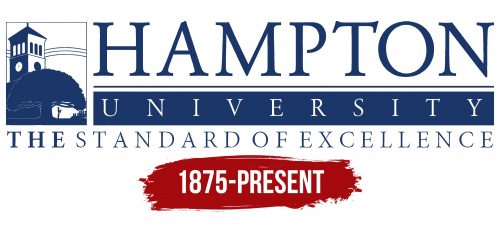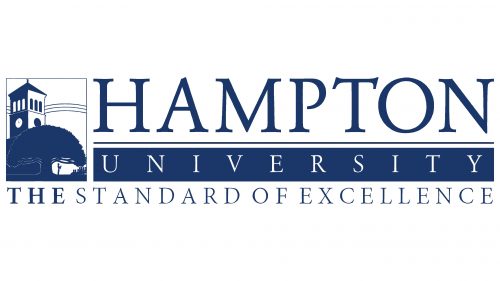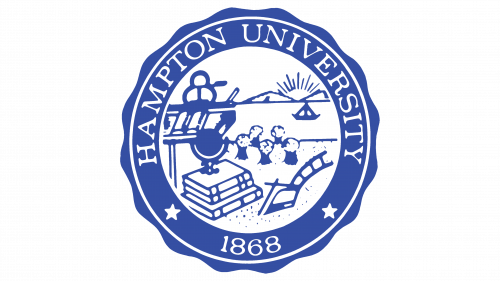The Hampton University logo combines an interweaving of important symbols, revealing the wonderful historical path of equality and openness in education for everyone. Each symbol of this logo emphasizes the unique aspects of the university’s history, reflecting its commitment to creating educational opportunities for everyone.
Hampton University: Brand overview
Hampton University, located in Hampton, Virginia, has a rich and significant history that dates back to the post-Civil War era. Founded in 1868, this historically black university has seen remarkable growth and transformation.
The university began as the Hampton Normal and Agricultural Institute, established by Brigadier General Samuel Chapman Armstrong. Armstrong, the son of missionaries in Hawaii, strongly advocated for the education of freed African Americans. He believed education was key to their integration into American society after slavery was abolished.
The institute’s primary mission was to train teachers to educate African American students, addressing the urgent need for qualified educators after the Civil War. Practical skills in agriculture and trades were also emphasized, providing graduates with the tools to find employment and support themselves. One of the institute’s most notable early students was Booker T. Washington, who enrolled in 1872. Washington later founded Tuskegee University in Alabama and became a prominent African American leader, significantly raising the school’s profile and underscoring the importance of education for the African American community.
In the early 20th century, the institution continued to evolve. In 1916, the Hampton Museum was established, becoming the first museum in the South dedicated to African American art and history. This was a bold step at a time when racial segregation was the norm in the Southern states.
During World War I, the institute played a critical role in preparing African American officers for the U.S. Army, a major achievement considering the limited opportunities available to African Americans in the military.
Despite the hardships of the Great Depression in the 1930s, the school continued to grow, adding programs like aviation. At a time when African Americans had little access to the aviation industry, this program was especially important.
During World War II, the institute again contributed to the war effort by training African American soldiers, including nurses and sailors for the Army and Navy.
The school was active in the civil rights movement in the 1950s and 1960s. Faculty and students participated in protests against racial segregation and discrimination.
A defining moment came in 1984 when the institution changed its name to reflect its growing academic stature and expanded offerings.
Throughout the 1990s and 2000s, the university continued to modernize and expand, establishing new schools and research centers such as the Center for Atmospheric Sciences in 1996 and the School of Pharmacy in 1997.
The university strongly emphasizes STEM (science, technology, engineering, and mathematics) education. In 2003, the institution became the first historically black college or university (HBCU) to launch a satellite into space, marking a major achievement in space exploration.
2008, the university celebrated its 140th anniversary, hosting events to honor its accomplishments and rich history.
Throughout the 2010s, the institution maintained its reputation as one of the top HBCUs in the nation. It expanded its online programs, making education more accessible to students nationwide.
In 2018, the university celebrated its 150th anniversary, reflecting on its remarkable history and ongoing commitment to providing high-quality education to students from diverse backgrounds.
As of 2023, the school continues to uphold its mission of offering educational opportunities to African American students. Many of its graduates have significantly contributed to American society across various fields, including business, politics, science, and the arts. Known for its strong STEM, business, and humanities programs, the institution remains a leading HBCU in the United States, preserving its traditions while preparing future generations for success.
The university takes pride in leading NASA’s first and only mission fully directed by an HBCU.
Hampton University’s athletic team, known as the Hampton Pirates, competes at the highest level of collegiate sports as part of the Division I National Collegiate Athletic Association (NCAA). The Pirates are proud of their strong tradition of perseverance and success, particularly in football, basketball, and track.
Meaning and History
What is Hampton University?
This private research university offers undergraduate and graduate programs in liberal arts, natural sciences, engineering, business, and nursing. The university is known for its strong STEM programs, focusing on marine sciences, physics, and aerospace engineering. The campus blends modern and historical buildings, and the university’s symbol is the Emancipation Oak, an important landmark. With a low student-to-faculty ratio, each student receives individual attention and mentorship. The university’s athletic team, the Pirates, competes in NCAA Division I. The university actively encourages students to participate in research and internships, emphasizing developing leadership skills and community involvement. Many distinguished alumni have succeeded significantly in business, science, entertainment, and politics.
1875 – today
The university’s emblem represents a rectangular plaque with an image and text, each element of which carries deep symbolic meaning. The graphic part of the emblem depicts a scene that unites several significant symbols related to the history of Black education in America. This is no coincidence, as the university was founded after the Civil War to educate freed slaves.
In the background of the image is the tower of Marquand Memorial Chapel, which reaches a height of 46 meters. This architectural object is part of the university complex, recognized as a national historic landmark. The top of the building symbolizes the heights the university has reached, having started its history on the grounds of a former plantation.
In the image’s foreground is one of the most famous trees in the world — the Emancipation Oak, also known as the Freedom Tree. Under this very tree, in 1861, the first classes for Black people were held at a time when the state did not yet permit their official education. At that time, there was a camp where freed slaves came, and Mary Smith Peake conducted lessons for them. Today, this tree stands at the entrance to the campus and has become a significant landmark for both the university and the city.
The logo depicts a teacher conducting a lesson under this oak for students sitting on the ground in the shade of the tree. This scene takes us back to the past and symbolizes the university’s mission and goals, highlighting its historical significance.
At the top of the emblem are three wavy lines representing the Hampton River, which the windows of the first university campus overlooked. To the right of the image is the name of the university, written in capital dark blue serif letters. The institution’s name is tied to Hampton, Virginia, where the university was founded. The font style and color scheme convey the idea of a high level of education and the professionalism of the faculty.
The word “University” is placed on a dark blue background, which refers to the institution’s history, founded as a place for the education of Black students. Below the image and the university’s name is the inscription “Standard of Excellence,” which emphasizes the high level of education offered by the university and its commitment to excellence in all aspects of learning.
The Seal
Like its logo, the university seal is filled with symbols, each with deep meaning. The image represents the 1984 version of the seal when the institution changed its name from “institute” to “university.” The seal’s wavy edges are decorative, giving the emblem elegance. The outer border bears an inscription with the name of the university and the year of its founding, highlighting the importance of the historical context.
The central part of the seal features a depiction of nature — the sun rising over the Hampton River, where the university is located. This sunrise symbolizes the beginning of the institution’s journey, which brought development and opened the doors of education for all, regardless of their background. The rising sun reflects the idea of a new era in education and progress.
In the foreground, a field with a harvested crop can be seen, which reminds us that the university was founded as Hampton Agricultural and Industrial School on the site of a former plantation, where cotton was likely grown. This element of the seal points to the institution’s historical roots and original functions.
To the left of this field is a printing press, and below it, a pulpit, symbolizing the teaching process and the spread of knowledge. In the foreground are books and a globe, emphasizing the close connection between education and exploring the world in physical and intellectual terms.
On the right side of the seal is a fragment of rails and a train. This element refers to the Hampton Roads metropolitan area, whose campus windows overlooked this transportation artery. The rails symbolize forward movement and technological progress, which went hand in hand with the university’s development, and the train represents the connection to the outside world and the institution’s important role in society.
Each detail of the seal contributes to the overall picture, uniting history, education, knowledge, and progress, which have become the foundation for the university’s development and significance in the global educational system.






